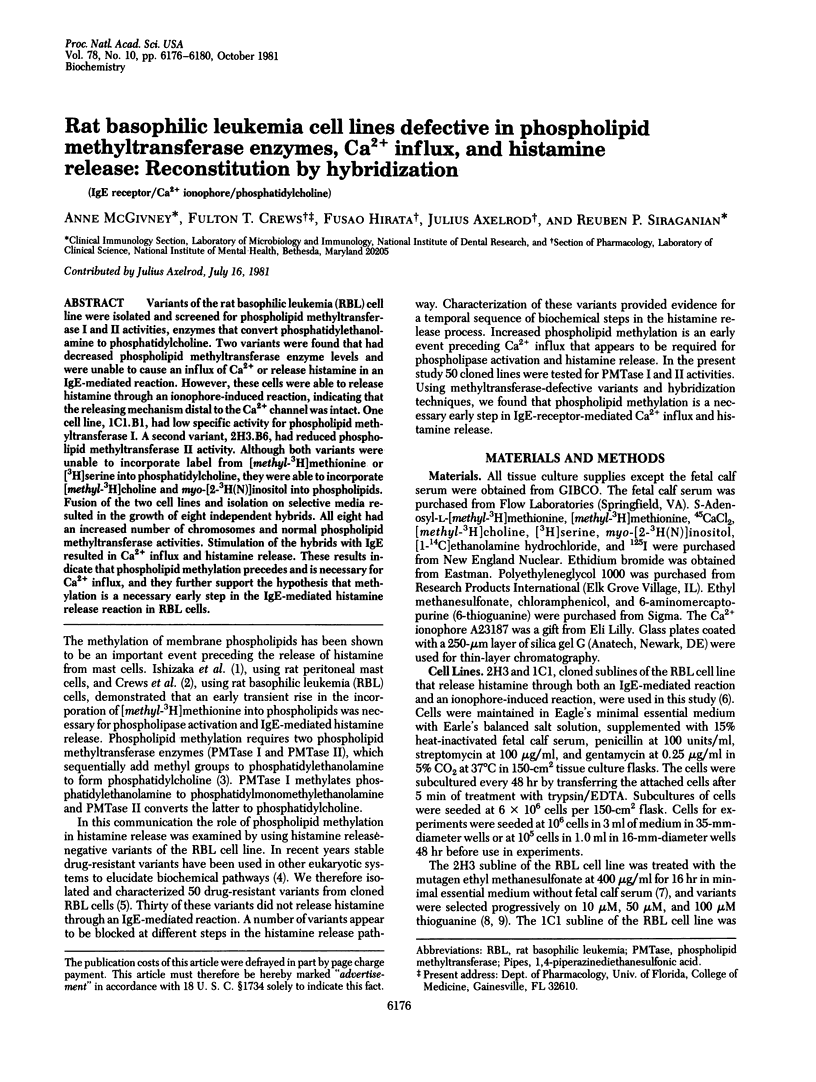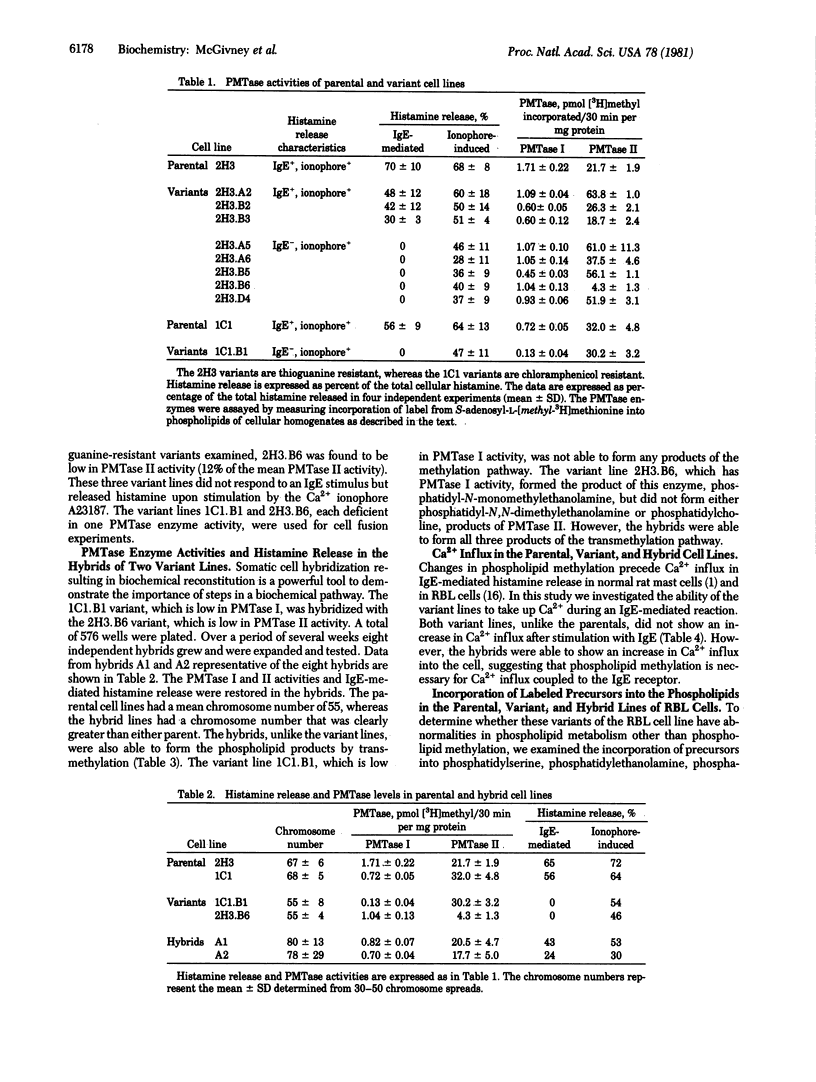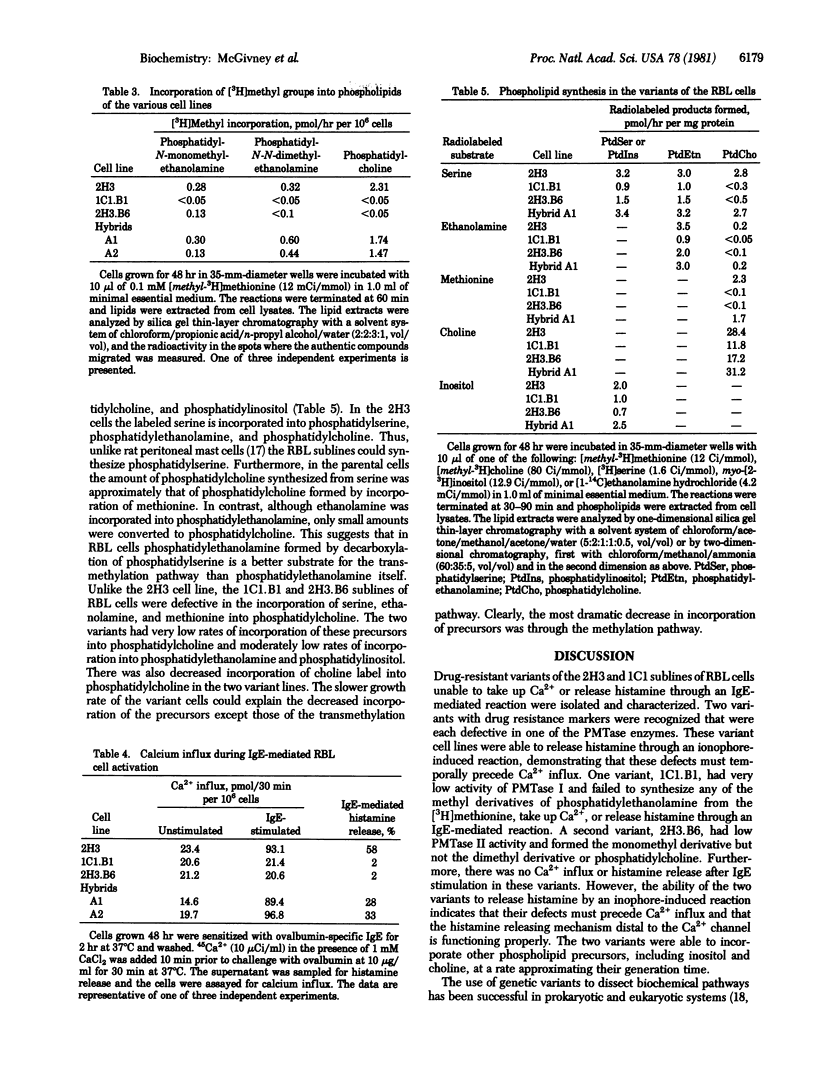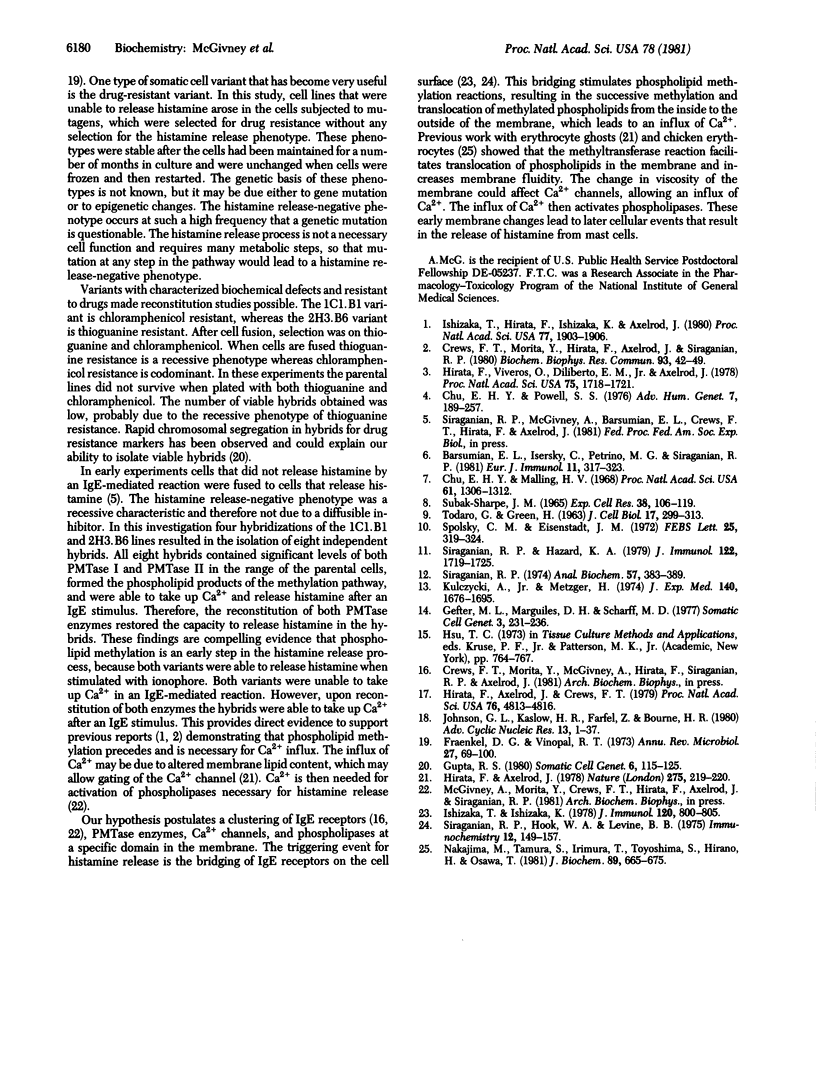Abstract
Variants of the rat basophilic leukemia (RBL) cell line were isolated and screened for phospholipid methyltransferase I and II activities, enzymes that convert phosphatidylethanolamine to phosphatidylcholine. Two variants were found that had decreased phospholipid methyltransferase enzyme levels and were unable to cause an influx of Ca2+ or release histamine in an IgE-mediated reaction. However, these cells were able to release histamine through an ionophore-induced reaction, indicating that the releasing mechanism distal to the Ca2+ channel was intact. One cell line, 1C1.B1, had low specific activity for phospholipid methyltransferase I. A second variant, 2H3.B6, had reduced phospholipid methyltransferase II activity. Although both variants were unable to incorporate label from [methyl-3H]methionine or [3H]serine into phosphatidylcholine, they were able to incorporate [methyl-3H]choline and myo-[2-3H(N)]inositol into phospholipids. Fusion of the two cell lines and isolation on selective media resulted in the growth of eight independent hybrids. All eight had an increased number of chromosomes and normal phospholipid methyltransferase activities. Stimulation of the hybrids with IgE resulted in CA2+ influx and histamine release. These results indicate that phospholipid methylation precedes and is necessary for Ca2+ influx, and they further support the hypothesis that methylation is a necessary early step in the IgE-mediated histamine release reaction in RBL cells.
Full text
PDF




Selected References
These references are in PubMed. This may not be the complete list of references from this article.
- Barsumian E. L., Isersky C., Petrino M. G., Siraganian R. P. IgE-induced histamine release from rat basophilic leukemia cell lines: isolation of releasing and nonreleasing clones. Eur J Immunol. 1981 Apr;11(4):317–323. doi: 10.1002/eji.1830110410. [DOI] [PubMed] [Google Scholar]
- Chu E. H., Malling H. V. Mammalian cell genetics. II. Chemical induction of specific locus mutations in Chinese hamster cells in vitro. Proc Natl Acad Sci U S A. 1968 Dec;61(4):1306–1312. doi: 10.1073/pnas.61.4.1306. [DOI] [PMC free article] [PubMed] [Google Scholar]
- Chu E. H., Powell S. S. Selective systems in somatic cell genetics. Adv Hum Genet. 1976;7:189–258. doi: 10.1007/978-1-4757-0659-8_5. [DOI] [PubMed] [Google Scholar]
- Crews F. T., Morita Y., Hirata F., Axelrod J., Siraganian R. P. Phospholipid methylation affects immunoglobulin E-mediated histamine and arachidonic acid release in rat leukemia basophils. Biochem Biophys Res Commun. 1980 Mar 13;93(1):42–49. doi: 10.1016/s0006-291x(80)80243-9. [DOI] [PubMed] [Google Scholar]
- Gefter M. L., Margulies D. H., Scharff M. D. A simple method for polyethylene glycol-promoted hybridization of mouse myeloma cells. Somatic Cell Genet. 1977 Mar;3(2):231–236. doi: 10.1007/BF01551818. [DOI] [PubMed] [Google Scholar]
- Gupta R. S. Random segretation of multiple genetic markers from CHO-CHO hybrids: evidence for random distribution of functional hemizygosity in the genome. Somatic Cell Genet. 1980 Jan;6(1):115–125. doi: 10.1007/BF01538700. [DOI] [PubMed] [Google Scholar]
- Hirata F., Axelrod J., Crews F. T. Concanavalin A stimulates phospholipid methylation and phosphatidylserine decarboxylation in rat mast cells. Proc Natl Acad Sci U S A. 1979 Oct;76(10):4813–4816. doi: 10.1073/pnas.76.10.4813. [DOI] [PMC free article] [PubMed] [Google Scholar]
- Hirata F., Axelrod J. Enzymatic methylation of phosphatidylethanolamine increases erythrocyte membrane fluidity. Nature. 1978 Sep 21;275(5677):219–220. doi: 10.1038/275219a0. [DOI] [PubMed] [Google Scholar]
- Hirata F., Viveros O. H., Diliberto E. J., Jr, Axelrod J. Identification and properties of two methyltransferases in conversion of phosphatidylethanolamine to phosphatidylcholine. Proc Natl Acad Sci U S A. 1978 Apr;75(4):1718–1721. doi: 10.1073/pnas.75.4.1718. [DOI] [PMC free article] [PubMed] [Google Scholar]
- Ishizaka T., Hirata F., Ishizaka K., Axelrod J. Stimulation of phospholipid methylation, Ca2+ influx, and histamine release by bridging of IgE receptors on rat mast cells. Proc Natl Acad Sci U S A. 1980 Apr;77(4):1903–1906. doi: 10.1073/pnas.77.4.1903. [DOI] [PMC free article] [PubMed] [Google Scholar]
- Ishizaka T., Ishizaka K. Triggering of histamine release from rat mast cells by divalent antibodies against IgE-receptors. J Immunol. 1978 Mar;120(3):800–805. [PubMed] [Google Scholar]
- Johnson G. L., Kaslow H. R., Farfel Z., Bourne H. R. Genetic analysis of hormone-sensitive adenylate cyclase. Adv Cyclic Nucleotide Res. 1980;13:1–37. [PubMed] [Google Scholar]
- Kulczycki A., Jr, Metzger H. The interaction of IgE with rat basophilic leukemia cells. II. Quantitative aspects of the binding reaction. J Exp Med. 1974 Dec 1;140(6):1676–1695. doi: 10.1084/jem.140.6.1676. [DOI] [PMC free article] [PubMed] [Google Scholar]
- Nakajima M., Tamura E., Irimura T., Toyoshima S., Hirano H., Osawa T. Mechanism of the concanavalin A-induced change of membrane fluidity of chicken erythrocytes. J Biochem. 1981 Feb;89(2):665–675. doi: 10.1093/oxfordjournals.jbchem.a133244. [DOI] [PubMed] [Google Scholar]
- SUBAK-SHARPE H. BIOCHEMICALLY MARKED VARIANTS OF THE SYRIAN HAMSTER FIBROBLAST CELL LINE BHK21 AND ITS DERIVATIVES. Exp Cell Res. 1965 Apr;38:106–119. doi: 10.1016/0014-4827(65)90432-5. [DOI] [PubMed] [Google Scholar]
- Siraganian R. P. An automated continuous-flow system for the extraction and fluorometric analysis of histamine. Anal Biochem. 1974 Feb;57(2):383–394. doi: 10.1016/0003-2697(74)90093-1. [DOI] [PubMed] [Google Scholar]
- Siraganian R. P., Hazard K. A. Mechanisms of mouse mast cell activation and inactivation for IgE-mediated histamine release. J Immunol. 1979 May;122(5):1719–1725. [PubMed] [Google Scholar]
- Spolsky C. M., Eisenstadt J. M. Chloramphenicol-resistant mutants of human HeLa cells. FEBS Lett. 1972 Sep 15;25(2):319–324. doi: 10.1016/0014-5793(72)80514-3. [DOI] [PubMed] [Google Scholar]
- TODARO G. J., GREEN H. Quantitative studies of the growth of mouse embryo cells in culture and their development into established lines. J Cell Biol. 1963 May;17:299–313. doi: 10.1083/jcb.17.2.299. [DOI] [PMC free article] [PubMed] [Google Scholar]


